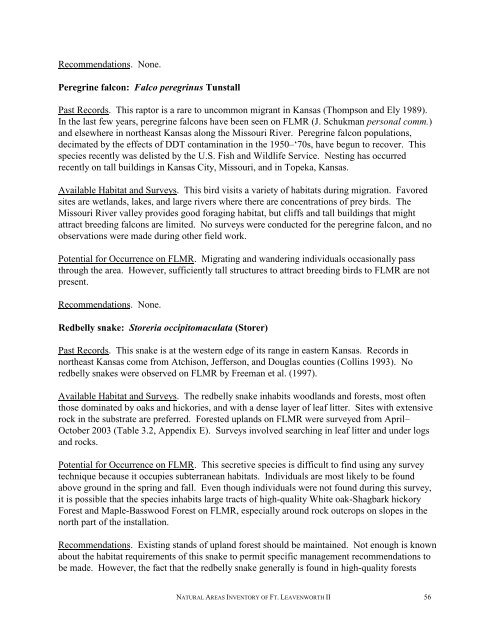A Natural Areas Inventory of the - Kansas Natural Heritage Inventory ...
A Natural Areas Inventory of the - Kansas Natural Heritage Inventory ...
A Natural Areas Inventory of the - Kansas Natural Heritage Inventory ...
You also want an ePaper? Increase the reach of your titles
YUMPU automatically turns print PDFs into web optimized ePapers that Google loves.
Recommendations. None.<br />
Peregrine falcon: Falco peregrinus Tunstall<br />
Past Records. This raptor is a rare to uncommon migrant in <strong>Kansas</strong> (Thompson and Ely 1989).<br />
In <strong>the</strong> last few years, peregrine falcons have been seen on FLMR (J. Schukman personal comm.)<br />
and elsewhere in nor<strong>the</strong>ast <strong>Kansas</strong> along <strong>the</strong> Missouri River. Peregrine falcon populations,<br />
decimated by <strong>the</strong> effects <strong>of</strong> DDT contamination in <strong>the</strong> 1950–‘70s, have begun to recover. This<br />
species recently was delisted by <strong>the</strong> U.S. Fish and Wildlife Service. Nesting has occurred<br />
recently on tall buildings in <strong>Kansas</strong> City, Missouri, and in Topeka, <strong>Kansas</strong>.<br />
Available Habitat and Surveys. This bird visits a variety <strong>of</strong> habitats during migration. Favored<br />
sites are wetlands, lakes, and large rivers where <strong>the</strong>re are concentrations <strong>of</strong> prey birds. The<br />
Missouri River valley provides good foraging habitat, but cliffs and tall buildings that might<br />
attract breeding falcons are limited. No surveys were conducted for <strong>the</strong> peregrine falcon, and no<br />
observations were made during o<strong>the</strong>r field work.<br />
Potential for Occurrence on FLMR. Migrating and wandering individuals occasionally pass<br />
through <strong>the</strong> area. However, sufficiently tall structures to attract breeding birds to FLMR are not<br />
present.<br />
Recommendations. None.<br />
Redbelly snake: Storeria occipitomaculata (Storer)<br />
Past Records. This snake is at <strong>the</strong> western edge <strong>of</strong> its range in eastern <strong>Kansas</strong>. Records in<br />
nor<strong>the</strong>ast <strong>Kansas</strong> come from Atchison, Jefferson, and Douglas counties (Collins 1993). No<br />
redbelly snakes were observed on FLMR by Freeman et al. (1997).<br />
Available Habitat and Surveys. The redbelly snake inhabits woodlands and forests, most <strong>of</strong>ten<br />
those dominated by oaks and hickories, and with a dense layer <strong>of</strong> leaf litter. Sites with extensive<br />
rock in <strong>the</strong> substrate are preferred. Forested uplands on FLMR were surveyed from April–<br />
October 2003 (Table 3.2, Appendix E). Surveys involved searching in leaf litter and under logs<br />
and rocks.<br />
Potential for Occurrence on FLMR. This secretive species is difficult to find using any survey<br />
technique because it occupies subterranean habitats. Individuals are most likely to be found<br />
above ground in <strong>the</strong> spring and fall. Even though individuals were not found during this survey,<br />
it is possible that <strong>the</strong> species inhabits large tracts <strong>of</strong> high-quality White oak-Shagbark hickory<br />
Forest and Maple-Basswood Forest on FLMR, especially around rock outcrops on slopes in <strong>the</strong><br />
north part <strong>of</strong> <strong>the</strong> installation.<br />
Recommendations. Existing stands <strong>of</strong> upland forest should be maintained. Not enough is known<br />
about <strong>the</strong> habitat requirements <strong>of</strong> this snake to permit specific management recommendations to<br />
be made. However, <strong>the</strong> fact that <strong>the</strong> redbelly snake generally is found in high-quality forests<br />
NATURAL AREAS INVENTORY OF FT. LEAVENWORTH II 56


